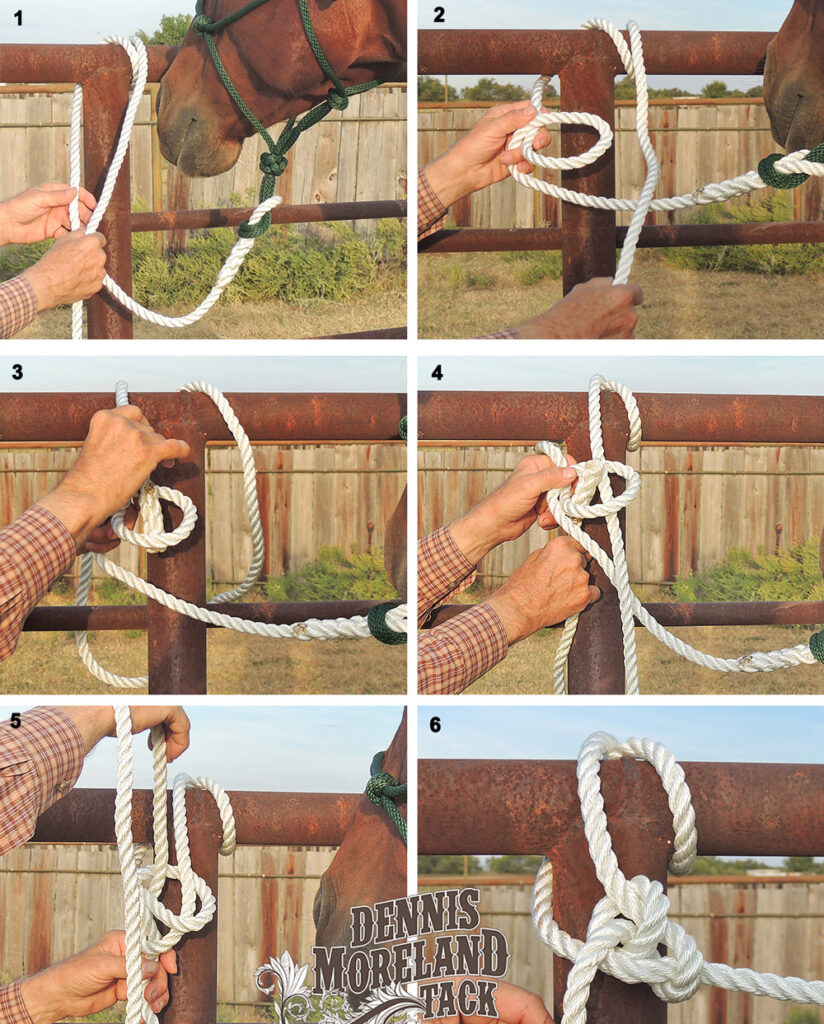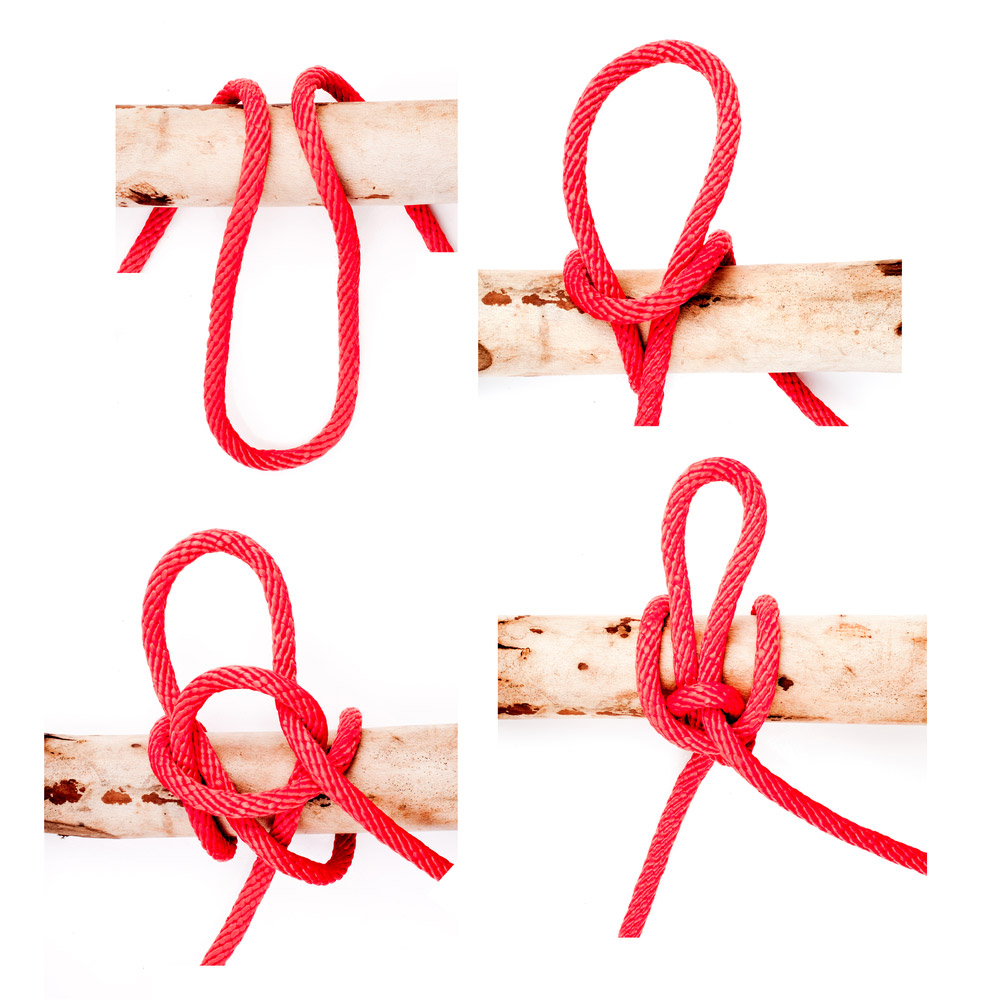Tying up your horse is needed when you want your horse to stay still. Whether you travel or compete, this skill is a must. There are various types of horse knots that suit different conditions. You have to know the common ones for safely tying horses. Here, you’ll find out what Bowline, Clove, and Bank Robber knots mean.
How to Tie a Horse Halter to the Fence
A Bowline is a great option if you need to tie your horse safely outside. This quick-release knot is called a “three-bite knot”. A Bowline is the best knot for lead ropes. As it’s attached to the horse’s neck, the knot won’t tighten if pulled.
When tying knots, use a fixed object like fence posts (never a fence rail) or a tree. You can always get your horse easily untied even if your horse pulls back. Tie your horse at withers level or slightly higher. Make sure your horse’s head can rest in its natural way.
Here’s how to tie a horse knot called a Bowline:
- Get the horse to the fence where the post crosses the rail. Using the post ensures your horse won’t move up and down the fence rail.
- Before tying your horse, make sure you attached a lead rope to the rope halter.
- Take the rope end and around the back of the horizontal rail so it’s on the right of the post. The free end is in your right hand. While the end attached to the halter is in your left hand.
- Make a small loop with the rope on the left side of the pole. The tail end gets out on the underside of the rope loop.
- Get the end in your right hand through the small loop. Bring it from the top.
- Grasp the end of the rope. Then go over and back under the part of the rope that goes to the halter.
- Put the loose end back up through the loop that is in your left hand.
- Hang on to the rope end that is attached to the halter with your left hand. Pull the free end to get the tight knot.

How to Tie a Horse to a Post
The quick-release knot’s ability to get an emergency exit is perfect for a fence post. If a tied horse panics, it will be released with a single tug. You may also consider attaching a tie ring screwed in the pole. You’ll feel that tying up a horse is fairly easy.
You may need a lead rope of the length of two to three feet. That is enough for most horses. Ponies can be tied shorter. There should be just enough slack so the horse can easily move its head. But not too loose to avoid the leg tripping over the rope.
Here’s how to tie a quick-release knot to a post:
- A safety string provides an added safety precaution in case of a foolproof breakaway. Tie up a loop of baling twine through the tie ring or a post.
- Thread the free end of the rope through the loop of the safety string. If you have no string and no ring, just go around the post.
- Bring the end over the lead rope. Go around and underneath to create a loop.
- Fold the tail to create another loop and bring the doubled-up end through the rope loop.
- Pull the end to tighten the knot.
- In the case of a Houdini Horse (one that can untie itself), do the following. Tuck the end of the rope through the loop. In such a position, the knot can’t be untied just by a tug.

How to Tie a Horse to a Hitching Post
The benefit of a quick-release knot lies in fast untying from the fence. In the case of a frightened horse, it can break free safely. Here’s another horse knot that is great for a hitching post. It’s called a Clove Hitch.
- Bring the tail end over the hitching rail. Bring it back to the horse and then over the pipe again. The end crosses over the horse rope.
- Hold the end that comes to the horse in your right hand. With your left hand, fold the free end and bring it up to create a loop.
- Keep pulling the tail end of the rope to release it and put it over the pole.
- Pull the end with your left hand to tighten the knot.
- To bring more security, get back to step #2 where you created the loop. With your left hand, grab the loop and bring it down and under the horse rope. Thread the end of the secure loop over the horse rope and through the loop you just created. Hold the horse rope with your right hand and tighten the loop with your left hand.
- The tail end is rested down. If it’s too long, you can secure it too. Thread the end through the last loop behind the hitching rail. Tighten it up.

How to Tie a Horse in a Trailer
Tying a horse in a trailer ensures it will be transferred safely. Besides, the horse won’t bother other horses and won’t turn around. Most trailers designed for horses come with safety rings attached to the walls.
Use a rapid-release knot in a trailer. You can use one of those described above or try the Bank Robber’s knot. It’s also called a Getaway Hitch. Here’s how to tie it up:
- Fold a rope to create a loop with your right hand.
- Put the loop through the ring. Hold it with your right hand.
- Grasp the loose end with your left hand and go underneath the loop to the left.
- Then go over the loop with the loose end. Thread the free end between the loop and the end attached to the horse.
- Pick it up and make another loop with this end. Make it with your right hand while holding the first loop with your left hand.
- Put the new loop inside the first loop and hold it up.
- Hold that loop with your left hand. Pull the end attached to the horse to tighten the knot. You can use both hands if needed.
- To untie the horse, you just need to tug the end once and you’re done.

What Is a Breakaway Halter?
A breakaway halter helps to quickly release a horse when it’s tied. Such a halter is commonly used when a horse is attached to a trailer. If the animal panics, it can easily break free with no harm to the neck. Breakaway halters are usually designed with a breakaway tab or a breakaway crown. The horse gets untied when it pulls out the rope. A breakaway halter costs around $30.

How to Teach a Horse to Ground Tie
A ground-tied horse means the equine stands still with no need to tie it up. Such a trick requires some time and training. Here are useful tips that might help you to ground tie your horse.
Start with making your horse stand like a halter horse. All four legs create a square shape. In such a position, an equine isn’t apt to move. Make sure none of the legs don’t go forward or backward. When the legs create a square, it’s harder to make an attempt to move.
When you train your horse to ground tie, don’t go away from its head. As it’s usually a “follow me” sign. Instead, start petting your horse from its head, then go to the back end and walk away. This will add a chance to keep your horse still.
The next step is to make the horse get used to standing alone. When you walk away from your companion, let him stand alone in the middle of the arena. Lots of horses may feel anxious when they’re left alone. That’s a hard part you have to overcome. Don’t leave your horse for long at first.
Start moving away from your horse, pet it, and drop off the reins. If the horse starts following you, say “Whoa”. That’s a command that means “stop” when you ride on a horse saddle. Try bringing the horse back to its tracks if it takes a step forward. When you repeat it several times, the horse starts to get it needs to stay completely immobile.
If your horse starts to move away, kindly get it back. Don’t run and don’t make rapid moves. Otherwise, you can scare your horse. Move slowly and treat your horse gently. When you check the horse is in the same steps, you can walk away from the side.
Repeat these steps over and over again. Don’t put lots of pressure. Your horse will get what you want over time. Just don’t make too big of a problem about training. Soon after you’ll be able to walk away from the horse’s head when ground tie.

Essential Horse Knots Explained
Both rookie and pro riders must know how to get their horse tied. To do so, use a halter and a lead rope. Horse bridle reins are not good for tying your horse. In case of rapid pulling, your horse may hurt its mouth when tied.
Thus, consider quick-released knots to tie up your horse. The true value of such knots lies in their feature to free the horse with no harm. Trailering a horse might be stressful and securing an equine is a must. Check this guide to get the hang of horse knots.
Image Source: shutterstock.com, dmtack.com, tmml.org.au.
